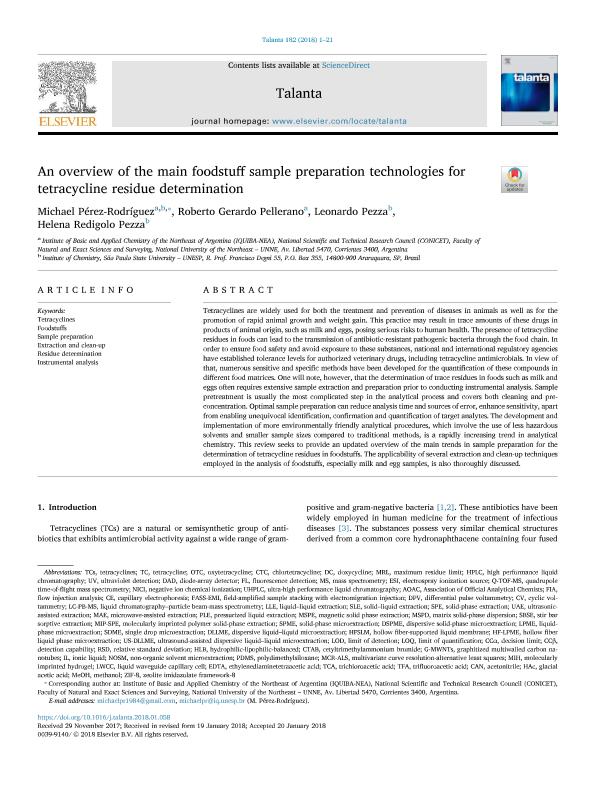Mostrar el registro sencillo del ítem
dc.contributor.author
Pérez Rodríguez, Michael

dc.contributor.author
Pellerano, Roberto Gerardo

dc.contributor.author
Pezza, Leonardo
dc.contributor.author
Redigolo Pezza, Helena
dc.date.available
2020-01-29T21:49:28Z
dc.date.issued
2018-05
dc.identifier.citation
Pérez Rodríguez, Michael; Pellerano, Roberto Gerardo; Pezza, Leonardo; Redigolo Pezza, Helena; An overview of the main foodstuff sample preparation technologies for tetracycline residue determination; Elsevier Science; Talanta; 182; 5-2018; 1-21
dc.identifier.issn
0039-9140
dc.identifier.uri
http://hdl.handle.net/11336/96191
dc.description.abstract
Tetracyclines are widely used for both the treatment and prevention of diseases in animals as well as for the promotion of rapid animal growth and weight gain. This practice may result in trace amounts of these drugs in products of animal origin, such as milk and eggs, posing serious risks to human health. The presence of tetracycline residues in foods can lead to the transmission of antibiotic-resistant pathogenic bacteria through the food chain. In order to ensure food safety and avoid exposure to these substances, national and international regulatory agencies have established tolerance levels for authorized veterinary drugs, including tetracycline antimicrobials. In view of that, numerous sensitive and specific methods have been developed for the quantification of these compounds in different food matrices. One will note, however, that the determination of trace residues in foods such as milk and eggs often requires extensive sample extraction and preparation prior to conducting instrumental analysis. Sample pretreatment is usually the most complicated step in the analytical process and covers both cleaning and pre-concentration. Optimal sample preparation can reduce analysis time and sources of error, enhance sensitivity, apart from enabling unequivocal identification, confirmation and quantification of target analytes. The development and implementation of more environmentally friendly analytical procedures, which involve the use of less hazardous solvents and smaller sample sizes compared to traditional methods, is a rapidly increasing trend in analytical chemistry. This review seeks to provide an updated overview of the main trends in sample preparation for the determination of tetracycline residues in foodstuffs. The applicability of several extraction and clean-up techniques employed in the analysis of foodstuffs, especially milk and egg samples, is also thoroughly discussed.
dc.format
application/pdf
dc.language.iso
eng
dc.publisher
Elsevier Science

dc.rights
info:eu-repo/semantics/openAccess
dc.rights.uri
https://creativecommons.org/licenses/by-nc-sa/2.5/ar/
dc.subject
EXTRACTION AND CLEAN-UP
dc.subject
FOODSTUFFS
dc.subject
INSTRUMENTAL ANALYSIS
dc.subject
RESIDUE DETERMINATION
dc.subject
SAMPLE PREPARATION
dc.subject
TETRACYCLINES
dc.subject.classification
Química Analítica

dc.subject.classification
Ciencias Químicas

dc.subject.classification
CIENCIAS NATURALES Y EXACTAS

dc.title
An overview of the main foodstuff sample preparation technologies for tetracycline residue determination
dc.type
info:eu-repo/semantics/article
dc.type
info:ar-repo/semantics/artículo
dc.type
info:eu-repo/semantics/publishedVersion
dc.date.updated
2019-10-28T16:50:34Z
dc.journal.volume
182
dc.journal.pagination
1-21
dc.journal.pais
Países Bajos

dc.journal.ciudad
Amsterdam
dc.description.fil
Fil: Pérez Rodríguez, Michael. Consejo Nacional de Investigaciones Científicas y Técnicas. Centro Científico Tecnológico Conicet - Nordeste. Instituto de Química Básica y Aplicada del Nordeste Argentino. Universidad Nacional del Nordeste. Facultad de Ciencias Exactas Naturales y Agrimensura. Instituto de Química Básica y Aplicada del Nordeste Argentino; Argentina
dc.description.fil
Fil: Pellerano, Roberto Gerardo. Consejo Nacional de Investigaciones Científicas y Técnicas. Centro Científico Tecnológico Conicet - Nordeste. Instituto de Química Básica y Aplicada del Nordeste Argentino. Universidad Nacional del Nordeste. Facultad de Ciencias Exactas Naturales y Agrimensura. Instituto de Química Básica y Aplicada del Nordeste Argentino; Argentina
dc.description.fil
Fil: Pezza, Leonardo. Universidade Estadual Paulista Julio de Mesquita Filho; Brasil
dc.description.fil
Fil: Redigolo Pezza, Helena. Universidade Estadual Paulista Julio de Mesquita Filho; Brasil
dc.journal.title
Talanta

dc.relation.alternativeid
info:eu-repo/semantics/altIdentifier/url/https://www.sciencedirect.com/science/article/pii/S003991401830064X
dc.relation.alternativeid
info:eu-repo/semantics/altIdentifier/doi/https://doi.org/10.1016/j.talanta.2018.01.058
Archivos asociados
